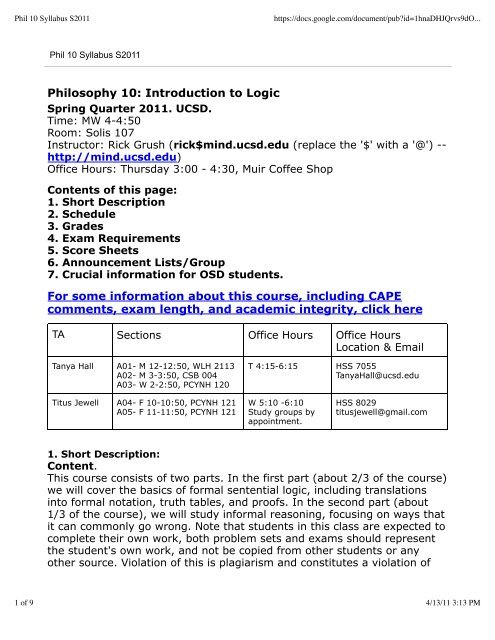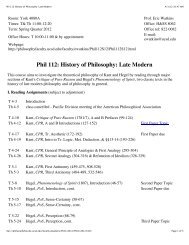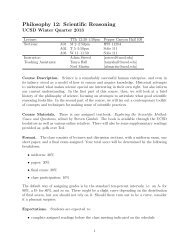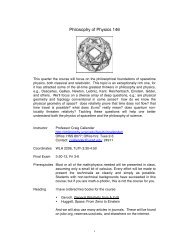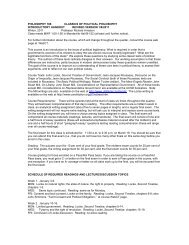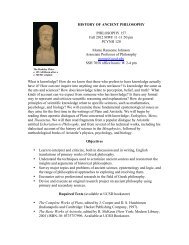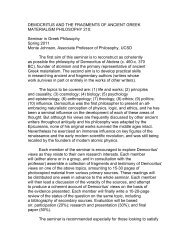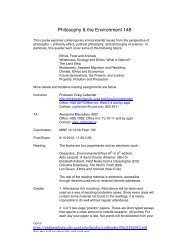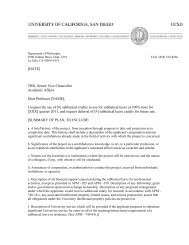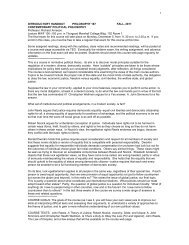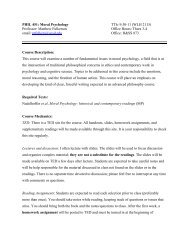Phil 10 Syllabus S2011 - UCSD Department of Philosophy
Phil 10 Syllabus S2011 - UCSD Department of Philosophy
Phil 10 Syllabus S2011 - UCSD Department of Philosophy
You also want an ePaper? Increase the reach of your titles
YUMPU automatically turns print PDFs into web optimized ePapers that Google loves.
<strong>Phil</strong> <strong>10</strong> <strong>Syllabus</strong> <strong>S2011</strong><br />
https://docs.google.com/document/pub?id=1hnaDHJQrvs9dO...<br />
<strong>Phil</strong> <strong>10</strong> <strong>Syllabus</strong> <strong>S2011</strong><br />
<strong>Phil</strong>osophy <strong>10</strong>: Introduction to Logic<br />
Spring Quarter 2011. <strong>UCSD</strong>.<br />
Time: MW 4-4:50<br />
Room: Solis <strong>10</strong>7<br />
Instructor: Rick Grush (rick$mind.ucsd.edu (replace the '$' with a '@') --<br />
http://mind.ucsd.edu)<br />
Office Hours: Thursday 3:00 - 4:30, Muir C<strong>of</strong>fee Shop<br />
Contents <strong>of</strong> this page:<br />
1. Short Description<br />
2. Schedule<br />
3. Grades<br />
4. Exam Requirements<br />
5. Score Sheets<br />
6. Announcement Lists/Group<br />
7. Crucial information for OSD students.<br />
For some information about this course, including CAPE<br />
comments, exam length, and academic integrity, click here<br />
TA Sections Office Hours Office Hours<br />
Location & Email<br />
Tanya Hall A01- M 12-12:50, WLH 2113<br />
A02- M 3-3:50, CSB 004<br />
A03- W 2-2:50, PCYNH 120<br />
T 4:15-6:15 HSS 7055<br />
TanyaHall@ucsd.edu<br />
Titus Jewell A04- F <strong>10</strong>-<strong>10</strong>:50, PCYNH 121<br />
A05- F 11-11:50, PCYNH 121<br />
W 5:<strong>10</strong> -6:<strong>10</strong><br />
Study groups by<br />
appointment.<br />
HSS 8029<br />
titusjewell@gmail.com<br />
1. Short Description:<br />
Content.<br />
This course consists <strong>of</strong> two parts. In the first part (about 2/3 <strong>of</strong> the course)<br />
we will cover the basics <strong>of</strong> formal sentential logic, including translations<br />
into formal notation, truth tables, and pro<strong>of</strong>s. In the second part (about<br />
1/3 <strong>of</strong> the course), we will study informal reasoning, focusing on ways that<br />
it can commonly go wrong. Note that students in this class are expected to<br />
complete their own work, both problem sets and exams should represent<br />
the student's own work, and not be copied from other students or any<br />
other source. Violation <strong>of</strong> this is plagiarism and constitutes a violation <strong>of</strong><br />
1 <strong>of</strong> 9 4/13/11 3:13 PM
<strong>Phil</strong> <strong>10</strong> <strong>Syllabus</strong> <strong>S2011</strong><br />
https://docs.google.com/document/pub?id=1hnaDHJQrvs9dO...<br />
class and University policy.<br />
Structure.<br />
There are two lectures per week, and one discussion section. Grades are<br />
based on exams given in class.<br />
Text, lecture podcasts, and other materials.<br />
The text for the course is Basic Sentential Logic and Informal Fallacies<br />
(BSLIF), which is available at <strong>UCSD</strong> bookstore. This text is brief, and<br />
covers everything you will need to know, and nothing that you won't need<br />
to know. The text also contains the homework, and practice exams for<br />
both midterms and the final exam. So <strong>of</strong> all the materials for the course, it<br />
is probably the most important.<br />
In addition to the text, there is a logic website for this course, that has<br />
additional exercises with solutions.<br />
Also, all lectures -- including video, audio, and pdfs <strong>of</strong> powerpoint<br />
slides -- are freely available for download.<br />
1. You can watch the videos online on Yahoo Videos, here:<br />
http://video.yahoo.com/search/?p=<strong>UCSD</strong>+logic<br />
The Yahoo Video requires a device with Flash capability. If you have<br />
something without Flash (like an iPhone or iPad),<br />
you can watch the videos by clicking on these links<br />
Lecture 1 -- Lecture 2 -- Lecture 3 -- Lecture 4 -- Lecture 5<br />
Lecture 6 -- Lecture 7 -- Lecture 8 -- Lecture 9 -- Lecture <strong>10</strong><br />
Lecture 11 -- Lecture 12 -- Lecture 13 -- Lecture 14 -- Lecture 15<br />
2. You can download the video files (in quicktime format) themselves<br />
onto your computer. Click here to go to a list <strong>of</strong> all movie files.<br />
3. PDFs <strong>of</strong> the powerpoint slides can be downloaded here.<br />
4. Audio files <strong>of</strong> the lectures (the same as the video lectures only<br />
without the video part) are here. These probably won't make much<br />
sense unless you also have the PDFs <strong>of</strong> the slides available (see (4)<br />
above). This audio with printouts <strong>of</strong> the slides is for anyone who has a<br />
non-video mp3 player.<br />
2. Schedule:<br />
The following schedule is subject to change. The due dates for problem<br />
sets as well as the dates <strong>of</strong> midterm exams may have to be changed for<br />
any number <strong>of</strong> reasons. This doesn't happen frequently, but it does happen<br />
from time to time. Therefore, you should plan to be available for all <strong>of</strong><br />
2 <strong>of</strong> 9 4/13/11 3:13 PM
<strong>Phil</strong> <strong>10</strong> <strong>Syllabus</strong> <strong>S2011</strong><br />
https://docs.google.com/document/pub?id=1hnaDHJQrvs9dO...<br />
these sessions. Schedule family vacations or whatever else on a day that<br />
this class meets at your own risk. If the schedule changes such that an<br />
exam falls on a day that you were planning to not be available, this does<br />
not constitute an excuse for missing the exam. See the 'make up exams'<br />
section below for more detail. If any due dates or exam days change,<br />
these changes will be announced on the google group as soon as known.<br />
Session 01 (3.28) BSLIF 1.1<br />
Session 02 (3.30) BSLIF 1.1-1.2<br />
Session 03 (4.04) BSLIF 2.1-2.2<br />
Session 04 (4.06) BSLIF 2.3<br />
Session 05 (4.11) BSLIF 2.4<br />
Session 06 (4.13) BSLIF 2.5<br />
Session 07 (4.18)<br />
Midterm One<br />
Session 08 (4.20) BSLIF 3.1<br />
Session 09 (4.25) BSLIF 3.2<br />
Session <strong>10</strong> (4.27) BSLIF 3.3<br />
Session 11 (5.02) BSLIF 3.4<br />
Session 12 (5.04) BSLIF 3.5<br />
Session 13 (5.09)<br />
Midterm Two<br />
Session 14 (5.11) BSLIF 4.1 – 4.4<br />
Session 15 (5.16) BSLIF 4.5 – 5.2<br />
Session 16 (5.18) BSLIF 5.3 – 5.6<br />
Session 17 (5.23) BSLIF 5.7 – 6.2<br />
Session 18 (5.25) BSLIF 6.3 – 6.4<br />
Session 19 (6.01) ?<br />
Final Exam: Thursday June 9, 3:00pm – 6:00 pm, Room TBA<br />
3. Grades:<br />
There are <strong>10</strong>00 points possible for the course. This is broken down as<br />
follows: 200 for each <strong>of</strong> two midterms exams, for a total <strong>of</strong> 400. The final<br />
is worth 400 points. And eight homework sets are worth a total <strong>of</strong> 200<br />
points.<br />
The final exam's 400 points are broken down as follows. <strong>10</strong>0 will<br />
correspond to material from Midterm One. <strong>10</strong>0 will correspond to material<br />
from Midterm 2. The remaining 200 points will cover material covered in<br />
the last third <strong>of</strong> the course: everything after Midterm Two.<br />
Letter grades will not be assigned until after all points are in. The<br />
worst-case scenario is that it will be a straight <strong>10</strong>% breakdown:<br />
90%-<strong>10</strong>0% will be A-, A or A+; 80%-89.9% will be B-, B or B+; and so<br />
forth. So if you need to get a C-, for example, you should plan on getting<br />
at least 700 points out <strong>of</strong> the <strong>10</strong>00 possible. Depending on the class<br />
average, the grade cut-<strong>of</strong>fs may be curved downward a bit -- for example<br />
one quarter the A- cut-<strong>of</strong>f was 880 points rather than 900. But you should<br />
not count on any such curving down. The grade cut-<strong>of</strong>fs will not be curved<br />
up, however, meaning that the straight <strong>10</strong>% breakdown is the highest that<br />
the grade cut-<strong>of</strong>fs will be set.<br />
3 <strong>of</strong> 9 4/13/11 3:13 PM
<strong>Phil</strong> <strong>10</strong> <strong>Syllabus</strong> <strong>S2011</strong><br />
https://docs.google.com/document/pub?id=1hnaDHJQrvs9dO...<br />
A note on curves: By definition, a curve is something that can only apply<br />
when one is deciding how to map points onto letters. We don't do this until<br />
the end <strong>of</strong> the term when the final is over and all points are in. Therefore,<br />
there's no point in asking, after the first or second midterm, if there was<br />
any curve. If you want an idea <strong>of</strong> what letter your current points will get<br />
you, see the paragraph just above this one.<br />
Special pleading at the end <strong>of</strong> the course will have no effect. Every<br />
quarter a certain number <strong>of</strong> students who apparently need to pass the<br />
class in order to graduate or remain eligible for some sort <strong>of</strong> aid, or<br />
whatever, miss the C- cut-<strong>of</strong>f, or the D cut-<strong>of</strong>f, or whatever it is that they<br />
need. Some <strong>of</strong> these students are then unable to graduate, or maintain<br />
eligibility for something, etc. If this is your situation then you need to<br />
make sure you pass the class. We have <strong>of</strong>fice hours and are happy to help<br />
if you are having trouble with the material; practice exams are available<br />
for you to assess your own level <strong>of</strong> preparation. I and the TAs are happy to<br />
spend time with anyone who needs it to help them get a handle on the<br />
material so they can do well on the exams. But it is your responsibility to<br />
attend lecture, attend sections, study the material, do problem sets, and<br />
take practice exams, and and come to <strong>of</strong>fice hours if you need help. We<br />
will NOT adjust grades after they have been assigned, except in cases<br />
where an actual error <strong>of</strong> some sort has been made. See the section below<br />
on how to do well in this course for more advice on how to insure that<br />
you pass the class. It is no fun being unable to graduate because you<br />
missed a C- by 2 points out <strong>of</strong> <strong>10</strong>00, and I don't like having to be the one<br />
who fills out the D or F on the grade sheet. So do us both a favor and be<br />
certain that you learn the material well enough to pass the class. I<br />
apologize for the negative tone <strong>of</strong> this paragraph, but I take it that the vast<br />
majority <strong>of</strong> the students in this class who work hard and study the material<br />
do so on the assumption that the grade they earn on that basis means<br />
something. They are depending on me to not do things like give some<br />
other student who didn't work as hard to understand the material as well<br />
the same grade just because this other student did some lobbying after the<br />
quarter was over. Every student's grade is determined by the points they<br />
receive, including those who miss a grade cut-<strong>of</strong>f by 1 point out <strong>of</strong> <strong>10</strong>00. I<br />
am spending so much time on this topic because, as I said, I don't like<br />
being the one who fills out the F or D on the grade sheet for a student who<br />
was planning to graduate, has a job lined up, etc. So please, study, attend<br />
lecture, do the practice exams, go to section -- and ask questions if there<br />
is stuff you don't understand. See me or the TAs is you need help. Don't<br />
take a risk by not studying, skipping lectures or homework, and try to<br />
estimate how much you can slack <strong>of</strong>f and 'probably' still pass. To sum up:<br />
the time to come see me (or your TA) is before you get the bad grade,<br />
enough before so we can help you to not get the bad grade, not after.<br />
4 <strong>of</strong> 9 4/13/11 3:13 PM
<strong>Phil</strong> <strong>10</strong> <strong>Syllabus</strong> <strong>S2011</strong><br />
https://docs.google.com/document/pub?id=1hnaDHJQrvs9dO...<br />
No make-up exams will be given. If you miss a midterm exam for a<br />
legitimate reason, such as serious medical injury or illness, then the points<br />
will be made up in the following way: The final exam has sections that<br />
correspond to material from Midterm One and Midterm Two -- each worth<br />
<strong>10</strong>0 points. If a student misses a midterm exam for a legitimate reason,<br />
then the points that the student earns on that section <strong>of</strong> the final that<br />
corresponds to the missed exam will be multiplied by 2, and that number<br />
used for the student's exam score (because <strong>10</strong>0 x 2 = 200). Legitimate<br />
reasons include serious illness with a doctor's note. Personal travel plans<br />
that conflict with the schedule, forgetting about the exam, etc., are not<br />
legitimate excuses.<br />
In order to help accommodate students with scheduling issues, an early<br />
version <strong>of</strong> the final will be given, usually 4 - 7 days before the normally<br />
scheduled exam, depending on the final exam schedule. Exact place and<br />
time will be announced in class and on the email lists.<br />
4. Requirements for taking the exams:<br />
No notes or books or other materials are allowed during the exam. You will<br />
need only one or more blue books, and one or more writing implements.<br />
The exam will have a sheet where you record your multiple choice<br />
answers. All work, and solutions to problems that are not multiple choice,<br />
must be written in the blue books. The exam should be placed inside the<br />
blue book and turned in with it when you turn your exam in.<br />
Time is a factor in the exams. In order to ensure that everyone has the<br />
same amount <strong>of</strong> time, the following procedures are implemented. The first<br />
page <strong>of</strong> the exam is the multiple choice answer sheet. When we hand out<br />
the exams, do not turn that page and start working on the exam until we<br />
say so, which we will do when everyone has a copy <strong>of</strong> the exam. This will<br />
ensure that everyone has the same start time. I will keep time, and will<br />
write on the board rough estimates <strong>of</strong> how much time is left. I will<br />
announce when 5 minutes are left, then 2, then 1, then 30 seconds, then<br />
<strong>10</strong> seconds, and will count down from 5 to 0. There will be a number <strong>of</strong><br />
boxes in which you must turn in your exam. Any <strong>of</strong> the designated boxes is<br />
fine. When the announced time reaches zero, lids are placed on the boxes,<br />
and any exam not in the box at that time will have <strong>10</strong> points deducted, no<br />
exceptions. This will ensure that everyone has the same end time. But let<br />
me be perfectly clear: the lids will be placed on the boxes<br />
simultaneously with the beginning <strong>of</strong> my pronunciation <strong>of</strong> the 'z' in<br />
zero. If your exam is not entirely in the box at that instant, then it<br />
will have <strong>10</strong> points deducted. So, for example, if any part <strong>of</strong> your hand<br />
is still touching any part <strong>of</strong> the paper on your blue book when the 'z' in<br />
5 <strong>of</strong> 9 4/13/11 3:13 PM
<strong>Phil</strong> <strong>10</strong> <strong>Syllabus</strong> <strong>S2011</strong><br />
https://docs.google.com/document/pub?id=1hnaDHJQrvs9dO...<br />
'zero' begins to sound, then you've just lost <strong>10</strong> points. I belabor this<br />
because every quarter, especially for the first exam, there are anywhere<br />
from 1 to 4 students who are standing near one <strong>of</strong> the designated boxes,<br />
and when they hear 'zero' and see the lid go on, reach out to stick their<br />
exam in, apparently thinking that being within a second or two <strong>of</strong> the<br />
announcement <strong>of</strong> 'zero' is good enough. And then they are surprised to see<br />
me take the exam and put it in the <strong>10</strong>-points-<strong>of</strong>f stack. My<br />
recommendation would be to practice enough so that you are turning in<br />
your exam with 5 or <strong>10</strong> minutes to go (as a number <strong>of</strong> students do);<br />
failing that, even if there are questions unanswered, I would recommend<br />
having your exam in the box before I start the <strong>10</strong> second countdown. If<br />
there happens to be a crowd at the box you are at such that you can't get<br />
it in, then this is not an excuse. Hopefully that won't happen, but it is your<br />
responsibility to get your exam in the box before the lid goes on. The point<br />
<strong>of</strong> this procedure is fairness. Unless there is some absolutely clear and<br />
strictly enforced deadline, there will be some students who continue to<br />
work on their exam after the end <strong>of</strong> time has been announced, and<br />
students who did turn their exam in when time was up will then rightfully<br />
feel cheated, since those students who continued to work will have had<br />
more time on the exam. The only way to guarantee fairness for<br />
everyone is for there to be a clear and mercilessly enforced<br />
deadline. I apologize for the heavy-handed procedure on this, but I do it<br />
not because I like being heavy-handed, but because ensuring that<br />
everyone is treated absolutely equally is a high priority for me.<br />
Problem Sets<br />
There are a total <strong>of</strong> 8 problem sets for the quarter.<br />
Problem Set Due Dates:<br />
The exact dates and times they are due will be announced in class and<br />
on the course group page (see below). Late homework assignments will not<br />
be accepted, no exceptions. It is your responsibility to make sure your problem<br />
sets are in the hands <strong>of</strong> your TA by the due date and time.<br />
However, when figuring grades, we will replace your worst problem set score<br />
with your best problem set score. This is a safety net for you in case for some<br />
reason you are unable to turn in <strong>of</strong> your problem sets on time, such as a car<br />
accident or serious illness. It is not intended as a policy to allow anyone to just<br />
skip a problem set.<br />
5. Score Sheets<br />
Score sheets will be posted as pages to this group when they are available.<br />
These will be updated after each exam. Scores are listed by a coded<br />
version <strong>of</strong> your student ID number in order to protect privacy, as<br />
6 <strong>of</strong> 9 4/13/11 3:13 PM
<strong>Phil</strong> <strong>10</strong> <strong>Syllabus</strong> <strong>S2011</strong><br />
https://docs.google.com/document/pub?id=1hnaDHJQrvs9dO...<br />
per University regulations. In order to determine what your coded ID<br />
number is, do the following. Take your student ID number. This will be<br />
something like a letter followed by 8 digits, like "A01234567". Remove the<br />
letter and the first digit, and you're left with a string <strong>of</strong> 7 digits, like<br />
"1234567". Take the first four digits, and treat this as a 4 digit number<br />
(something between 0000 and 9999); and take the last four digits and<br />
treat this like another 4-digit number. In the example above, they would<br />
be "1234" and "4567". Add these two numbers together, for example:<br />
1234 + 4567 = 5801. If the number you get is 5 digits, remove the first<br />
digit to make it 4 digits long; if it is 4, then keep it at 4 digits. This is your<br />
coded ID number. To see another example: If your student ID is<br />
"A05367921", you drop the first letter and number: "5367921"; then take<br />
the first 4 digits: "5367"; and the last 4 digits "7921"; add them together:<br />
5367+7921=13288. If the result is 5 digits, remove the first digit: "3288".<br />
If you cannot find your row on the score sheet, first make sure you figured<br />
your coded ID correctly. 80% <strong>of</strong> the time students can't find their score it<br />
is because they figured their coded ID incorrectly. Next, check other score<br />
sheets, especially if you changed sections at some point in the quarter or<br />
added late. If you still have trouble, email me with your name, section,<br />
your student ID number, and what you figured your coded ID number to<br />
be.<br />
6. Online Announcement List:<br />
There is a Google group for this class, and it is a course requirement<br />
that you either subscribe to the list and set your membership to receive<br />
email announcements, or that you regularly, at least once or twice a week,<br />
check the page online to read the announcements. You can get to the<br />
announcement page here:<br />
http://groups.google.com/group/phil_<strong>10</strong>_ucsd_s_2011<br />
I recommend that you click on that link now, and sign up for the group.<br />
Don't worry, only I and the TAs can post, so you won't be getting a lot <strong>of</strong><br />
spam.<br />
If for whatever reason you don't wish to sign up, that is OK. You can still<br />
visit the page to read any announcements without signing up. But the<br />
announcements won't be emailed to you, you will have to remember to<br />
visit the page <strong>of</strong>ten to read the announcements. Remember, you are<br />
responsible for any information or announcements posted to this group.<br />
When the quarter is over, and it is clear that no more announcements will<br />
be needed (like where to pick up finals, or whatever), I will delete this<br />
group. So if you are subscribed, there will be no need to unsubscribe.<br />
7 <strong>of</strong> 9 4/13/11 3:13 PM
<strong>Phil</strong> <strong>10</strong> <strong>Syllabus</strong> <strong>S2011</strong><br />
https://docs.google.com/document/pub?id=1hnaDHJQrvs9dO...<br />
How to do well in this course:<br />
Subscribe to the announcement list. Attend all the lectures, and read the<br />
corresponding chapters <strong>of</strong> the text before the lecture. Attend the<br />
discussion sections, and do all problem sets. Use them, and other<br />
non-assigned exercises (in the text or on the website) to determine for<br />
yourself how well you have mastered the material. If anything doesn't<br />
make sense, you can see the lecture again in video version (see above),<br />
you can read the relevant parts <strong>of</strong> the book again. And <strong>of</strong> course if you<br />
need additional help, ask your TA or myself. We have <strong>of</strong>fice hours. The<br />
earlier you get clear on some issue that is giving you trouble, the better it<br />
will be for everybody.<br />
For each exam, 2 practice exams are available in the text. I recommend<br />
that before the actual exam, you administer one <strong>of</strong> the exams to yourself,<br />
giving yourself only 45 minutes. Then grade your exam (answers will be<br />
posted on this group). This will allow you to find what material, if any, you<br />
need to work on some more. Consult myself or the TA, or simply do more<br />
exercises <strong>of</strong> the type you need to improve on until you feel you have<br />
mastered this material. Repeat the proceedure with the second practice<br />
exam.<br />
This will be a very manageable class IF you simply keep up with the<br />
material, regularly practice by doing exercises, and ask for help as soon<br />
as you need it.<br />
Many students end up getting grades much worse than they expect<br />
because they do not follow the above advice. The material looks easy when<br />
you read through it or watch someone else work a pro<strong>of</strong> or truth table, and<br />
many students then think "That looks easy, I'll be able to do that on a<br />
test." But as some students learn the hard way, watching someone do it is<br />
a lot easier than doing it yourself. Furthermore, the exams are long.<br />
Purposefully long. Most students do not finish them. The only way to get to<br />
the point where you can do the problems quickly and accurately is to do a<br />
lot <strong>of</strong> practice. [Amazingly, I give people this advice every time I teach this<br />
class, and every time a large chunk <strong>of</strong> students still fall into exactly these<br />
traps.]<br />
7. Information for OSD students:<br />
If you are a student approved by OSD for special accommodations, you need to<br />
coordinate with me beforehand. For students who need 1.5 times the regular exam<br />
time, the usual practice is to start midterm exams an hour earlier than the scheduled<br />
time, and the final 2 hours before. The location is usually the department library. But<br />
for EACH exam for which you need accommodations, you should email me between 2<br />
and 4 days prior to the exam to set up and verify the time and place. If I do not hear<br />
8 <strong>of</strong> 9 4/13/11 3:13 PM
<strong>Phil</strong> <strong>10</strong> <strong>Syllabus</strong> <strong>S2011</strong><br />
https://docs.google.com/document/pub?id=1hnaDHJQrvs9dO...<br />
from you at least 2 days prior to the exam, then I cannot guarantee that I will be able<br />
to provide special accommodations.<br />
Edit this page (if you have permission) – Published by Google Docs – Report Abuse – Updated automatically<br />
every 5 minutes<br />
9 <strong>of</strong> 9 4/13/11 3:13 PM


